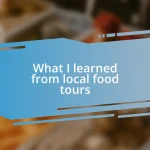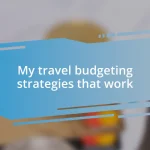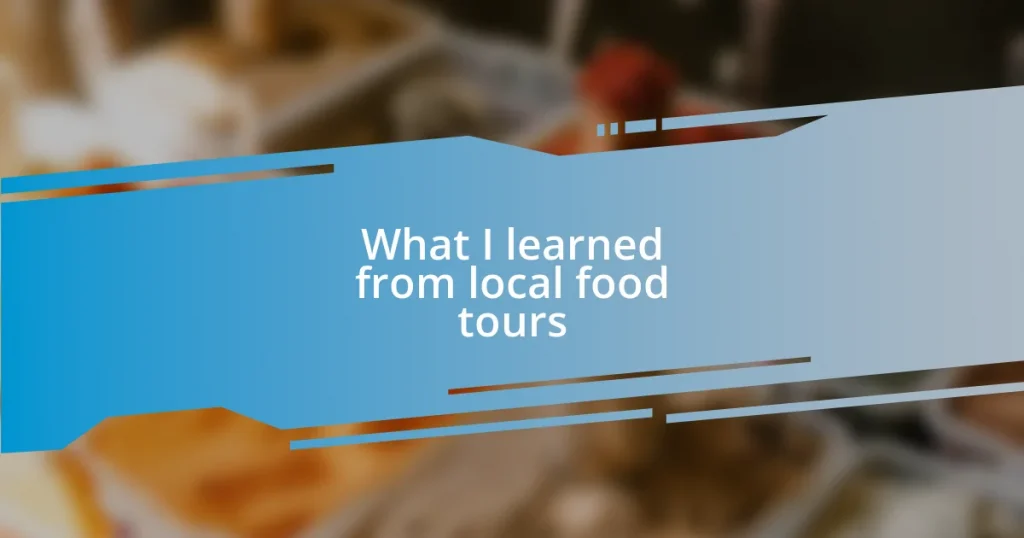Key takeaways:
- Embracing emotion and experimentation in music creation can lead to unique and authentic outcomes.
- Finding inspiration in daily life, through observation and reflection, can enrich musical expression and creativity.
- Collaborating with diverse artists and using technology can expand creative boundaries and enhance the musical process.

Understanding creativity in music
Creativity in music is a deeply personal journey that can take many forms. I remember a late night in the studio when I felt completely stuck; nothing was hitting the right chord. In that moment of frustration, I asked myself, “What if I let go of my expectations and just played from the heart?” That shift changed everything for me.
One aspect of creativity that often gets overlooked is the emotional connection we have with our music. When I create, it’s not just about the notes or lyrics; it’s about what I’m feeling in that moment. I’ve found that tapping into my emotions, whether joy, sadness, or even nostalgia, brings a unique authenticity to the music. Isn’t it fascinating how those feelings can influence the notes we choose?
Understanding creativity in music also means embracing uncertainty and experimentation. I’ve had days where I picked up an unfamiliar instrument, unsure of what would come out of it, but that’s where the magic started. By letting go of the urge to control the outcome and allowing spontaneity to lead, I’ve uncovered sounds I never knew existed. What about you? Have you ever let yourself be surprised by your own creativity?

Finding inspiration from daily life
Finding inspiration in daily life is one of the most enriching aspects of being a musician. I often discover melodies in the most mundane moments—a conversation at a coffee shop or birds chirping outside my window. These snippets of everyday life serve as a backdrop, inviting me to translate those experiences into sound. For instance, during a stroll in my neighborhood, I once heard an ice cream truck’s jingle and immediately envisioned a playful, upbeat tune that echoed the nostalgia of childhood summers.
To harness daily life as a source of inspiration, I focus on:
- Observing My Surroundings: I take moments to really see and hear. A simple walk can reveal a treasure trove of sounds and sights.
- Reflecting on Conversations: Every chat has its own rhythm. I often jot down phrases or emotions that resonate, which later become lyrics or themes.
- Mapping Emotions to Experiences: I connect specific feelings to daily events. For instance, the warmth of baking cookies might inspire a comforting ballad.
- Documenting Ideas: I keep a journal of thoughts and impressions. Even the smallest detail can spark a creative breakthrough.
- Engaging with People: Listening to others’ stories often leads me to new perspectives, opening pathways for musical exploration.

Setting a routine for creativity
Setting a routine for creativity can seem paradoxical at first—how can structure enhance spontaneity? From my experience, establishing specific times for music creation transforms my artistic practice. I’ve noticed that when I designate certain hours as my “music time,” it almost becomes a sacred ritual, allowing my mind to shift gears into creative mode effortlessly.
I also find that the environment plays a critical role in nurturing creativity within a routine. For example, I have a cozy corner in my home that’s solely dedicated to music-making. Every time I sit there, it’s like flipping a switch; instantly, ideas flow more freely. Experimenting with different spots has taught me how a change in scenery can provoke fresh inspiration.
Another effective strategy is incorporating short breaks into my routine. I’ve learned that stepping away for a few moments—even for a quick walk or a cup of tea—can clear my mind and rejuvenate my creative energy. I often return with a new perspective or spark of creativity. Have you ever noticed how a little distance can lead to richer ideas?
| Aspect | Personal Experience |
|---|---|
| Designating Time | Creating a “music time” improves focus and intention. |
| Creating a Space | A dedicated area for music boosts creative flow. |
| Incorporating Breaks | Stepping away refreshes perspective and energy. |

Exploring different musical styles
Diving into different musical styles has been a revelation in my journey as a musician. I remember the first time I tried to incorporate jazz into my work. The complex rhythms and improvisational elements opened up a new world of creativity. It felt like a dance between structure and spontaneity—how could I capture that synergy in my own sound? This exploration taught me not just about music, but about embracing uncertainty and letting go of control.
What’s even more fascinating is how blending genres can lead to unexpected results. I once experimented with mixing classical melodies with modern electronic beats. The outcome was thrilling and completely out of my comfort zone. It sparked an idea for a whole album that fused storytelling with a diverse sound palette. Can you imagine how liberating it is to break boundaries? It’s like rediscovering what music can be all over again.
In my journey, I’ve also delved into folk music. The storytelling aspect deeply resonated with me, reminding me of the nights spent with friends around a campfire, sharing tales and harmonizing melodies. Those moments felt raw and real, showcasing how different styles can capture various emotions. How often do you experience the magic of music connecting us through shared stories? That connection is a reminder that the heart of music transcends genres and speaks to our shared humanity.

Collaborating with other artists
When I collaborate with other artists, it opens up pathways I never knew existed. I recall a jam session with a drummer friend, where we set aside our preconceived notions about our respective genres. As we exchanged ideas, I felt that unique energy spark creativity in ways that working solo rarely does. Have you ever noticed how bouncing ideas off someone else can lead to unexpected breakthroughs?
One of my most memorable collaborations was with a vocalist who had a flair for improvisation. I found myself tailoring my guitar riffs on the spot, responding to her voice as it soared. That instant connection on stage was electrifying! It’s incredible how the synergy between artists can lead to something bigger than ourselves, don’t you think?
Every collaboration offers a chance to learn and grow as a musician. I often seek out those whose styles are vastly different from mine. Recently, I worked with a hip-hop artist, and their approach to rhythm reshaped my perception of melody. It challenged me and pushed my creative boundaries further than I imagined possible. I wonder, how often do we allow ourselves to step out of our comfort zones to discover hidden talents?

Using technology to enhance creativity
Technology has been a game changer in how I approach creativity in music. I remember the first time I used a digital audio workstation (DAW) to lay down my ideas. The ability to experiment with different sounds and effects allowed me to dive deeper into my musical thoughts. It felt like having an entire studio at my fingertips! How often do we find that the right tools can unleash our hidden potential?
When I discovered looping software, I was amazed at how it transformed my practice sessions. I could layer different melodies, building dynamics and textures all at once, which opened my mind to new compositional techniques. There was this one evening when I created a piece that started with a simple guitar riff. As I looped it, I added harmonies and percussion, and suddenly, it morphed into something completely unexpected. Isn’t it fascinating how technology can turn a solitary moment into an epic musical experience?
Music apps have also become part of my daily routine. One app that I adore is a songwriting tool that offers rhymes and lyrical suggestions. I often find myself struggling with writer’s block, but this app nudges me into new directions. Just the other day, it helped me craft lyrics that I would have never thought of on my own. Have you ever experienced that rush of creativity when an unexpected idea strikes? I firmly believe that using technology in music isn’t just about the tools; it’s about how those tools inspire us to think differently and push boundaries.

Reflecting on progress and growth
Reflecting on my progress and growth as a musician has been a transformative journey for me. I often take a step back to listen to my older tracks, and it’s astonishing to hear how my style has evolved. There were moments when I struggled to find my voice, and now, I can see how those challenges shaped my creativity. Have you ever looked back on your work and felt a sense of pride in how far you’ve come?
It’s fascinating to recognize the small victories along the way. I remember a time when I attempted a genre I had never explored before—electronic music. The initial attempts felt clumsy, but every mistake taught me something valuable. Reflecting on this experience allows me to appreciate the growth that comes from stepping outside my comfort zone. Don’t you think that embracing discomfort can spark incredible breakthroughs?
I also keep a journal where I jot down my musical experiences and insights. It serves as a timeline of my artistic journey. Looking back, I can see patterns—what inspired me during certain phases or how specific collaborations led me to new artistic heights. This practice cultivates a deeper understanding of my creative process. Have you tried documenting your journey? The clarity it brings can truly enhance the way we perceive our growth as artists.
















